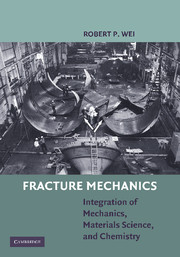Book contents
- Frontmatter
- Contents
- Preface
- Acknowledgments
- 1 Introduction
- 2 Physical Basis of Fracture Mechanics
- 3 Stress Analysis of Cracks
- 4 Experimental Determination of Fracture Toughness
- 5 Fracture Considerations for Design (Safety)
- 6 Subcritical Crack Growth: Creep-Controlled Crack Growth
- 7 Subcritical Crack Growth: Stress Corrosion Cracking and Fatigue Crack Growth (Phenomenology)
- 8 Subcritical Crack Growth: Environmentally Enhanced Crack Growth under Sustained Loads (or Stress Corrosion Cracking)
- 9 Subcritical Crack Growth: Environmentally Assisted Fatigue Crack Growth (or Corrosion Fatigue)
- 10 Science-Based Probability Modeling and Life Cycle Engineering and Management
- APPENDIX: Publications by R. P. Wei and Colleagues
- References
2 - Physical Basis of Fracture Mechanics
Published online by Cambridge University Press: 05 June 2012
- Frontmatter
- Contents
- Preface
- Acknowledgments
- 1 Introduction
- 2 Physical Basis of Fracture Mechanics
- 3 Stress Analysis of Cracks
- 4 Experimental Determination of Fracture Toughness
- 5 Fracture Considerations for Design (Safety)
- 6 Subcritical Crack Growth: Creep-Controlled Crack Growth
- 7 Subcritical Crack Growth: Stress Corrosion Cracking and Fatigue Crack Growth (Phenomenology)
- 8 Subcritical Crack Growth: Environmentally Enhanced Crack Growth under Sustained Loads (or Stress Corrosion Cracking)
- 9 Subcritical Crack Growth: Environmentally Assisted Fatigue Crack Growth (or Corrosion Fatigue)
- 10 Science-Based Probability Modeling and Life Cycle Engineering and Management
- APPENDIX: Publications by R. P. Wei and Colleagues
- References
Summary
In this chapter, the classical theories of failure are summarized first, and their inadequacy in accounting for the failure (fracture) of bodies that contain crack(s) is highlighted. The basic development of fracture mechanics, following the concept first formulated by A. A. Griffith, is introduced. The concepts of strain energy release rate and stress intensity factor, and their identification as the driving force for crack growth are introduced. The experimental determinations of these factors are discussed. Fracture behavior of engineering materials is described, and the importance of fracture mechanics in the design and sustainment of engineered systems is considered.
Classical Theories of Failure
Classical theories of failure are based on concepts of maximum stress, strain, or strain energy and assume that the material is homogeneous and free from defects. Stresses, strains, and strain energies are typically obtained through elastic analyses.
Maximum Principal Stress (or Tresca) Criterion
The maximum principal stress criterion for failure simply states that failure (by yielding or by fracture) would occur when the maximum principal stress reaches a critical value (i.e., the material's yield strength, σYS, or fracture strength, σf, or tensile strength, σUTS).
- Type
- Chapter
- Information
- Fracture MechanicsIntegration of Mechanics, Materials Science and Chemistry, pp. 9 - 25Publisher: Cambridge University PressPrint publication year: 2010



